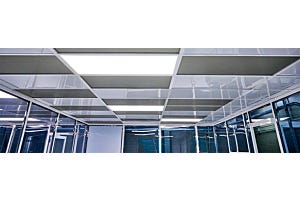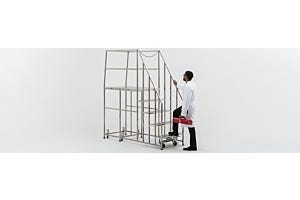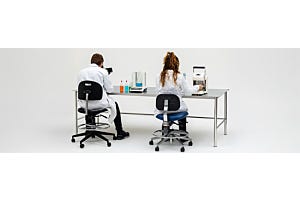Step by Step ISO Cleanroom Gowning Procedures, Gowning Order, Instructions
Where do most cleanroom contaminants come from? Simple: the cleanroom staff brings them in. With enough foot traffic, outside contaminants can easily migrate into your cleanroom — but the right safeguards will help your facility stay clean and compliant.
Welcome to Terra’s multi-part educational series on critical environments. Let's discuss selecting the right cleanroom protocols and procedures for your application.
Additionally, we’ll outline proper gowning procedures, as well as the Terra Universal equipment you’ll need to protect your room from cross-contamination.
Sources of Cleanroom Gowning Room Contamination
Improper gowning procedures are the most common source of cleanroom contamination. Humans carry billions of microscopic particles that can easily be shed from the skin, hair, or clothing. Wearing unsuitable attire or skipping steps in the garbing process can quickly lead to contaminated work areas, product failures, or cleanroom shutdowns.
Unsuitable furniture, featuring hard-to-clean pockets where dust and debris collect, is another common source of contamination. Terra’s BioSafe furniture includes rounded corners for easy cleaning, open surfaces to promote laminar airflow, and no cracks or crevices where microbes gather.
Specialized equipment can provide additional safeguards against cleanroom contamination.
- Automatic doors prevent the staff from touching door handles.
- Sticky flooring protects the cleanroom from wheel-borne contaminants.
- ISO-rated BioSafe carts comply with strict cleanroom requirements.
Gowning Room Design & How Are Gowning Rooms Classified?
When determining cleanroom construction and operation standards, the International Standards Organization, or ISO, categorizes cleanrooms based on the number of particles per cubic foot of air.
Cleanroom ISO classification is validated by particle measurements performed with a benchtop or handheld particle counter. The cleanest classification, ISO 3, denotes an environment containing 1 particle per cubic foot. The least rigorous classification, ISO 8, specifies an atmosphere containing 10,000 particles per cubic foot.
A well-designed gowning room will have some demarcation between the clean floor and the dirty floor. Not all facilities require or demand a dedicated, ISO-rated gowning area with room-to-room partitions.
For certain laboratories or pharmacy cleanrooms, gowning room design may be limited to a simple demarcation on the floor to designate the gowning area. In this case, because the gowning room is not separated from the cleanroom by an interior partition, the gowning equipment must meet or exceed the ISO class rating of the cleanroom (rather than the ISO rating of the gowning room).
For traditional cleanroom designs where wall partitions separate the cleanroom and gowning room, the interior cleanroom classification is typically one ISO class lower (cleaner) than the outer gowning cleanroom. Therefore, an ISO 7 cleanroom with ISO 8 gowning room will feature ISO 8-rated furniture.
Read More: Gowning Room Design: Making the Most of Your Space
Gowning Room Furniture Specifications
BioSafe Cleanroom Furniture
Unsuitable furniture with hard-to-clean, dust-collecting crevices represent significant contamination burdens in cleanrooms
Terra’s BioSafe Furnishings include rounded corners for easy cleaning, open surfaces to promote laminar airflow, and no cracks or crevices where microbes gather. All Terra cleanroom gowning benches feature corner-free construction with tube tops to minimize particle accumulation and simplify cleaning.
Gowning Platforms & Lean Rails
A gowning bench always separates the clean side from the dirty side.
For example, Terra’s cleanroom gowning platform explicitly demarcates the clean area in white from the dirty area in blue. On the "clean" side of the bench, laundered booties are allowed beyond the bench. On the dirty side of the bench is the dirty area where you can stand before you put on clean booties.
Terra’s curved modular benches include interconnecting straight and curved pieces to create systems with clear, demarcated clean, and dirty zones. Horseshoe and oval-shaped designs are common for facilities with busy gowning areas.
Double-Sided Cleanroom Lean Rails
Cleanroom lean rails offer an easy-to-clean, ergonomic gowning station to don and remove garments. The half-seated design saves time in busy gowning areas and minimizes shift-change congestion. Meanwhile, operators can safely balance on the lean rail while donning coveralls without needing to sit down or balance on one foot.
Read More: Cleanroom Gowning Benches - Features, Styles, Types, and Differences
Gowning Mirrors
Terra’s dual-sided mirror uses frameless construction and an electropolished stainless steel base for easy cleaning and positioning. The double-plate glass allows personnel to perform self-checks on either side of the mirror.
Gowning Room Dispensers
For streamlined gowning, Terra offers wall-mounted and free-standing dispensers that accommodate gloves, liners, and many other kinds of disposable PPE.
Cleanroom Gown Storage Cabinets
Standard cleanroom garment cabinets include one chamber with a hanging rod for frocks and coveralls, and a second with shelves for hoods, masks, and other supplies.
Double-sided cleanroom garment cabinets allow quick access and re-stocking of supplies from either side. Indeed, a welcomed solution for versatile island storage in cleanroom gowning areas with limited wall space.
Terra also offers models with a fan filtration system that uses a continuous stream of HEPA-filtered air to wash particles from stored garments.
Garment cabinets with HEPA filtration maintain low-particulate conditions during storage. Terra recommends that all reusable cleanroom garments be kept inside a controlled garment and supplies cabinet.
Read More: Gowning Areas that Support Clean Protocol
Cleanroom Pass-Through Chambers
Because cleanroom staff are a primary source of cleanroom contamination, reducing foot traffic into the cleanroom helps to limit particle influx.
Most gowning room designs include a pass-through chamber, also referred to as a transfer box, that allows items and materials to be introduced into the cleanroom from the outside. Utilizing a pass-through chamber for sample or equipment transfer limits the number of people entering and exiting the cleanroom. As an added benefit, minimizing entry and exit reduces room leakage, which makes room air pressure values more reliable and easier to maintain.
Read More: Medical Entry Systems Doors for Healthcare, Hospitals, and Clinics
Automatic Cleanroom Shoe Cleaning Machines
For automated donning, Terra’s automated shoe cleaning machines include a HEPA-filtered internal vacuum system with multiple rotating brushes that remove particles from deep inside the shoe seams. Place a shoe cleaning machine for cleanrooms at the entrance of your gowning room, along with sticky mats that remove fine particles from the bottom of your shoes.
Free-Standing BioSafe® Bootie Racks
BioSafe® Free Standing Bootie Racks feature a crevice-free design with rounded corners for easy disinfection. Stainless steel construction resists biocides, and will not produce contaminants during sterilization. Ideal for life science applications, such as environmental biology and food science.
BioSafe® Stainless Steel Crash Rails
Wall-mounted stainless steel safety guard rails are well-suited as physical protective barriers for conveyor lines, mezzanines, or pedestrian walkways. Crash rails feature heavy-duty 304 stainless steel with rectangle tubing that offers exceptional protection to resist impact, abrasion, moisture, germs, and UV rays. The tail ends of the crash rails are angled to help deflect corner impacts inside or outside cleanrooms, within packing or storage areas, or in areas hosting sensitive machines.
Step By Step Non-Sterile Cleanroom Gowning
Principles for Preventing Contamination During Cleanroom Gowning
- First, you should never let clean surfaces come into contact with dirty ones.
- You must keep garments away from dirty surfaces, including the floor.
- Never touch clean garments or materials until you’ve washed your hands
- During the gowning process, you must start at the top of your body and work your way down.
Step-by-Step Cleanroom Gowning Procedure
Let’s start at the beginning. The first critical step of the gowning procedure is to
- Remove all makeup, perfume, and hair gels.
- Remove personal items, like jewelry, car keys, and cell phones.
- Clean street shoes or don cleanroom-designated footwear
- Don shoe covers
- Enter gowning room
- Wash and dry your hands with a no-touch hand-washing and -drying station
- For ISO 6 or cleaner, don under glove or glove liners and sanitize gloves
- Don bouffant and then facemask (beards require beard guards)
- Retrieve garments from the cleanroom garment and supplies cabinet
- Don equipment, starting from the head, working towards the feet
- Don the cleanroom hood
- Put on your coverall - use a clean gowning bench or lean-rail for support
- Don cleanroom-rated boots or shoes (if specified)
- Don goggles (if specified)
- Don cleanroom gloves; If specified, adjust glove liners and disinfect before donning your cleanroom gloves. Booties and gloves should overlap the coverall.
- Final Visual Inspection - Before you enter the cleanroom, do a final visual self-check to ensure you haven’t missed anything.
Need Help with Product Configuration?
At Terra, we strive to develop and produce the highest quality products for our customers to improve health, safety, performance, and yields. Our product quality is enabled by high-grade manufacturing equipment and processes, 45 years of engineering and application expertise, and our commitment to continuously improve.
Shop Terra Universal products online for immediate pricing or configure your components and accessories for quoting.
Contact a Terra sales specialist via phone, webchat, or email for help with configuration, large purchases, or application expertise.
















